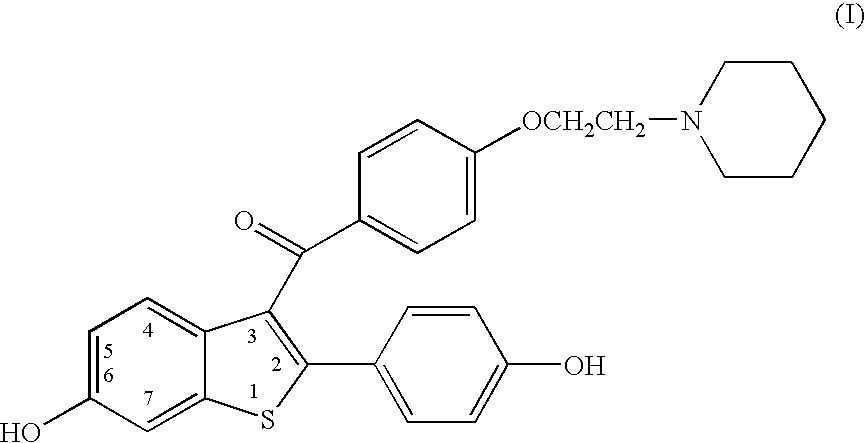Benzothiophenes, formulations containing same, and methods
a technology of benzothiophene and benzothiophene, which is applied in the field ofbenzothiophene compound, can solve the problems of increasing bone resorption and formation, affecting the effect of bone mass loss, and failing to provide adequate structural support for the body in the skeleton, so as to reduce the symptoms of osteoporosis, inhibit endometriosis, and reduce the lipid level
- Summary
- Abstract
- Description
- Claims
- Application Information
AI Technical Summary
Benefits of technology
Problems solved by technology
Method used
Image
Examples
preparation 1
6-Methoxy-2-(4-methoxyphenyl)benzo[b]thiophene
[0075]A solution of 3-methoxybenzenethiol (100 grams) and potassium hydroxide (39.1 grams) in water (300 mL) was added to denatured ethanol (750 mL), and the resulting mixture cooled to about 0° C. The cold mixture was treated with 4′-methoxyphenacyl bromide (164 grams) in several small portions. Upon complete addition, the mixture was cooled for an additional ten minutes, then allowed to warm to room temperature. After three hours, the mixture was concentrated in vacuo, and the residue treated with water (200 mL) The resulting mixture was treated with ethyl acetate, and the phases were separated. The organic phase was washed with water (2×), sodium bicarbonate solution (2×), and sodium chloride solution (2×). The organic phase was then dried over magnesium sulfate, filtered, and evaporated to dryness in vacuo to give 202 grams of α-(3-methoxyphenylthio)-4-methoxyacetophenone. This crude product was crystallized from methanol and washed ...
preparation 2
Ethyl 4-(2-Piperidinoethoxy)benzoate
[0077]A mixture of ethyl 4-hydroxybenzoate (8.31 g), 1-(2-chloroethyl)piperidine monohydrochloride (10.13 g), potassium carbonate (16.59 g), and methyl ethyl ketone (60 mL) was heated to 80° C. After one hour, the mixture was cooled to about 55° C. and treated with additional 1-(2-chloroethyl)piperidine mono-hydrochloride (0.92 g). The resulting mixture was heated to 80° C. The reaction was monitored by thin layer chromatography (TLC), using silica-gel plates and ethyl acetate / acetonitrile / triethylamine (10:6:1, v / v). Additional portions of 1-(2-chloroethyl)piperidine hydrochloride are added until the starting 4-hydroxybenzoate ester is consumed. Upon complete reaction, the reaction mixture was treated with water (60 mL) and allowed to cool to room temperature. The aqueous layer was discarded and the organic layer concentrated in vacuo at 40° C. and 40 mm Hg. The resulting oil was used in the next step without further purification.
preparation 3
4-(2-Piperidinoethoxy)benzoic Acid Hydrochloride
[0078]A solution of the compound prepared as described in Preparation 2 (about 13.87 g) in methanol (30 mL) was treated with 5 N sodium hydroxide (15 mL), and heated to 40° C. After 4½ hours, water (40 mL) was added. The resulting mixture was cooled to 5-10° C., and concentrated hydrochloric acid (18 mL) was added slowly. The title compound crystallized during acidification. This crystalline product was collected by filtration, and dried in vacuo at 40-50° C. to give 83% yield of the title compound. Melting point 270-271° C.
PUM
| Property | Measurement | Unit |
|---|---|---|
| size | aaaaa | aaaaa |
| mean particle size | aaaaa | aaaaa |
| size | aaaaa | aaaaa |
Abstract
Description
Claims
Application Information
 Login to View More
Login to View More - R&D
- Intellectual Property
- Life Sciences
- Materials
- Tech Scout
- Unparalleled Data Quality
- Higher Quality Content
- 60% Fewer Hallucinations
Browse by: Latest US Patents, China's latest patents, Technical Efficacy Thesaurus, Application Domain, Technology Topic, Popular Technical Reports.
© 2025 PatSnap. All rights reserved.Legal|Privacy policy|Modern Slavery Act Transparency Statement|Sitemap|About US| Contact US: help@patsnap.com



